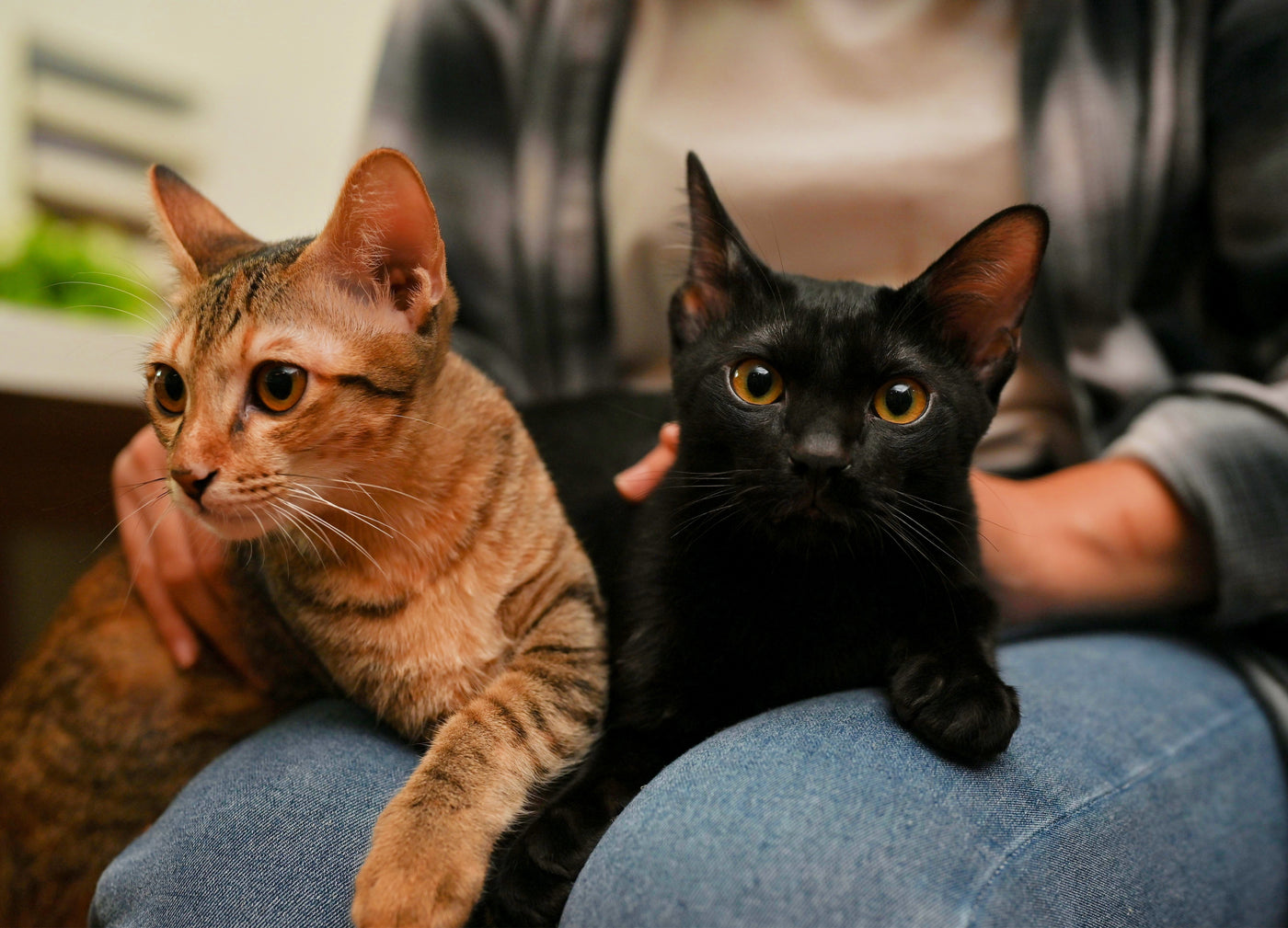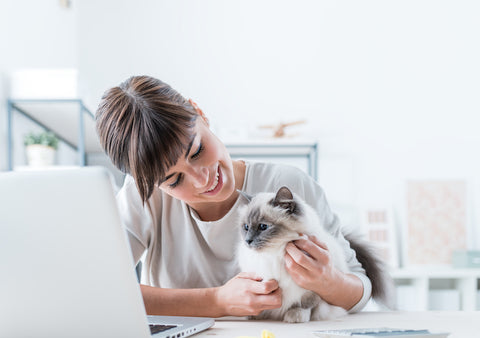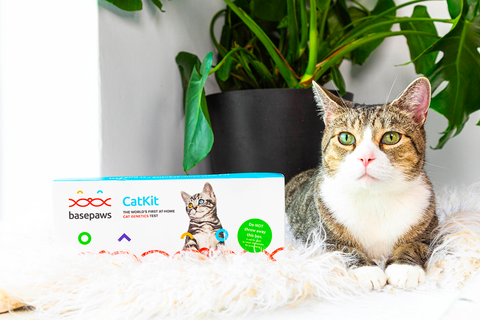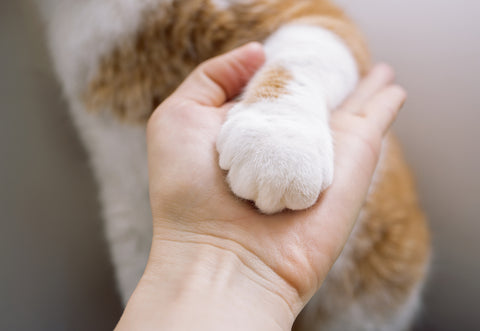
Today, we’re decoding one of the mysteries of genetics that relates to your Basepaws DNA report of results. It's called epistasis. When epistasis occurs, the observable expression (phenotype) of a gene—such as one responsible for the color of your kitty's coat—gets modified in some way by a completely different gene that has the ability to mask, suppress, or inhibit how that coat color gene is expressed. Epistasis helps explain why sometimes you may get a “likely to have” result for a genetic trait in your cat’s Basepaws report that doesn’t quite match up with their physical appearance.

“Standing Upon” the Expression of Other Genes
The word epistasis is composed of the prefix “epi-”, which is a Greek root that means “upon”, and “sta-”, a root meaning “to stand, or set down”. In genetics, we use the word epistasis to describe an interaction where the expression of one gene gets modified in some way, because one gene (or multiple genes) have the ability to “stand upon”, mask, suppress, or otherwise inhibit that expression.
Some examples of epistasis in cat coat genetics include genes that are involved in the pigmentation of coats. There are many such genes responsible for the phenotypes that we see in our favorite felines, such as their unique coat colors and patterns.
First, let’s review a bit of helpful genetics background about genes, alleles, and a common type of inheritance. Second, we’ll describe two genes that contribute to different phenotypes associated with feline coat colors and patterns, and finally, we’ll discuss the epistatic interaction that can occur between these two particular genes.
Your Cat’s Genes and Alleles
Your cat’s genome (the entire genetic material present in a cell) is the complete set of genetic instructions needed for their growth and development. As segments of DNA located along your kitty’s chromosomes, genes are the basic units of inheritance they received from their biological parents. Some genes code for proteins, which play an important role in every function of the body and directly relate to your cat’s unique physical and biological traits.
Did you know?
- Every gene that your cat inherits from their parents has two versions, called alleles.
- This is because one allele comes from their mother and the other allele from their father. Genes and their alleles occupy a specific position, or locus, on a chromosome.
- If the two gene alleles inherited from each parent for a trait such as coat color are the same, then the cat is homozygous for the particular allele. If the two alleles are different, then the cat is heterozygous.

Every cat has only two alleles for each gene they inherit. However, in the larger population, multiple alleles can exist for the same gene. This is because DNA segments within genes can have slight variations. These variations occur in the four bases that make up DNA: adenine (A), thymine (T), cytosine (C), and guanine (G).
Variations contribute to the many unique genotypes, or collections of different genes and alleles, that exist in a population and pass along to individual cats. Genotypes contribute to equally unique phenotypes, including the beautiful array of coat colors and patterns that kitties can have.

Types of Inheritance
Different types of inheritance affect the relationship between alleles, and this relationship contributes to a cat’s genotype (and, by extension, phenotype). While there are a few different types of inheritance, complete dominance will help frame our discussion and initial exploration of epistasis.
- Complete dominance portrays the relationship between two gene alleles at the same locus on a chromosome.
- Only one copy of a dominant allele is needed to express a dominant trait.
- However, there must be two copies of a recessive allele to express a recessive trait. In other words, traits associated with recessive alleles are expressed only in the absence of dominant alleles.
- Dominant alleles are represented by a capital letter (A,B,C), and recessive alleles by a lowercase letter (a,b,c).
Now, let’s learn more about two genes that contribute to different phenotypes associated with feline coat colors and patterns.
The Agouti and Orange/Red Cat Coat Genes
The Agouti (A) Gene
The agouti (A) gene, also known as the agouti signaling protein gene, controls the amount and distribution of a black to brown pigment called eumelanin, and of a red to yellow pigment called phaeomelanin. It does this by interacting with the melanocortin 1 receptor (MC1R) gene, and this results in a process of switching between black/brown and reddish/yellow as the hair shaft grows. This “on/off” switching process creates a pattern of banding, called agouti banding, on a cat’s individual hairs as seen in the closeup image of the cat coat below.

The dominant allele for the agouti (A) gene happens to also be written as a capital “A”. The recessive allele is written as a lowercase “a”. Table 1 below shows the different allele combinations associated with the possible genotypes for the agouti (A) gene that contribute to a cat’s phenotype (in this case, coat appearance):

Table 1. Allele combinations and possible genotypes for the agouti (A) gene
In the first two rows of the table, we see complete dominance at work. Whether a cat inherits the same two dominant gene alleles from each parent (A/A) or only inherits one dominant allele and one recessive allele (A/a or a/A) from each parent, it results in the cat having agouti-banded hair that has black/brown dark bands.
In the last row of the chart, when a cat inherits two recessive alleles (a/a), one from each parent, it results in a mutation that produces pigment throughout every strand of the cat’s fur. Evenly distributed pigment means that the cat will have a solid-colored coat. Sometimes, a faint agouti banding may be there such as in the cat displayed below, but overall, the cat looks like it has a solid-colored coat.

The Orange/Red (O) Gene
Phaeomelanin is a red to yellow pigment in the coats of cats and other mammals. The gene that codes for phaeomelanin is the orange/red (O) gene. Like the agouti gene, it has two alleles: the dominant (O) orange/red allele and the recessive (o) non-orange/red allele.
However, this gene has a different type of inheritance called “codominance”. With this type of inheritance, two alleles of the same gene can be expressed together to yield different phenotypes. In other words, instead of one trait being completely dominant over the other, it is possible to have both traits appear (i.e., orange/red pigment is expressed, as is the non-orange pigment, which would be black/brown).
The orange/red gene happens to be carried on the X chromosome. Females have two X chromosomes and will therefore carry two alleles of the orange/red gene. Below is a breakdown of all possible coat variations depending on what alleles a female cat carries (barring any epistatic interactions):
- If she is homozygous dominant (O/O), she will be orange/red toned since this genotype allows for the full expression of orange/red pigment phaeomelanin.
- If she is homozygous recessive (o/o) she will have non-orange/red pigmentation—instead, this genotype allows for full expression of the black/brown pigment eumelanin.
- Finally, if she is heterozygous (O/o), she will display the tortoiseshell phenotype, such as what you see in the cat below, that includes the expression of both orange/red phaeomelanin pigment and black/brown eumelanin pigment.

Males normally have one X and one Y chromosome; since they have only one X chromosome, they can only carry one allele of the orange/red gene—either the dominant O allele or the recessive o allele—so the genotype variations are limited. Since this makes it impossible to have the heterozygous (O/o) genotype, tortoiseshell cats are almost never male.
Epistasis: Orange/Red and Agouti Genes
We can finally put everything together and talk about epistasis as it relates to the orange/red (O) gene and the agouti (A) gene!
Let’s say that you get a “likely to have” result for solid or black coat coloration in the genetic traits section of your Basepaws report, but your cat doesn’t display either of these phenotypes. On the contrary, your kitty happens to have an orange tabby coat!
This is a case of epistasis, where the observable expression (phenotype) of the agouti (A) gene is being modified by the orange/red (O) gene.
The orange/red (O) gene is able to control a process that is not yet fully understood in genetics. This process results in epistasis—the “standing upon” or suppression of black/brown eumelanin in favor of orange/red pheomelanin.
While the homozygous recessive (o/o) genotype allows for the full expression of eumelanin in the agouti (A) gene, any genotype that includes a dominant O allele results in epistasis and masks the expression of eumelanin in the A gene. Table 2 below helps to illustrate:

Table 2. Adapted from Figure 1A in Schmidt-Küntzel et al. (2009).
This illustration of epistatic interaction between the orange/red (O) gene and the agouti (A) gene is but one known reason why you may get a “likely to have” result for black or solid-colored coat in the genetic traits section of your Basepaws report, but the result doesn’t match up with your cat’s phenotype. In summary, this result means that your cat tested positive for the mutation associated with the a/a recessive genotype, but either the epistatic effect of the O gene or multiple other mutations in other genes may be interacting with each other in a variety of ways that are yet to be discovered.
The possible combinations of mutations have the potential to produce phenotypes that are quite different from the conventional terms currently used in feline coat genetics, such as “black coat”. If we go back to our “genes and alleles” section of this post, we remember that variations contribute to the many genotypes, or collections of different genes and alleles, that exist in a population and pass along to individual cats. Genotypes contribute to equally unique phenotypes—including the beautiful array of coat colors, patterns, and lengths that kitties can have—and to further complicate matters, phenotype is also influenced by different environmental (aka non-genetic) factors!
Exciting Paws-ibilities to Discover
Scientists are still learning about the many genes and gene interactions that contribute to different phenotypes, or observable traits, seen in the coats of our favorite felines. The orange/red gene and the agouti gene are but two of many examples about which we still have much to learn.
For example, you may be wondering why we don’t test for the orange/red gene in the Basepaws Cat DNA Test. While we do know about the existence of this gene and that it is responsible for an epistatic effect on the expression of the agouti gene, scientists have yet to determine its exact location on the feline genome.
As part of the Basepaws community, you’re contributing to science that helps us unlock these and other mysteries of the feline genome so that we can learn more about what, genetically speaking, makes a cat a cat! Cat coat genetics is a fascinating subject, and we’ll continue to share more insights based on the latest scientific discoveries about the feline genome!
Want to learn more about your own kitty’s unique traits? A Basepaws Cat DNA Test will help you know them even better, both inside and out!



